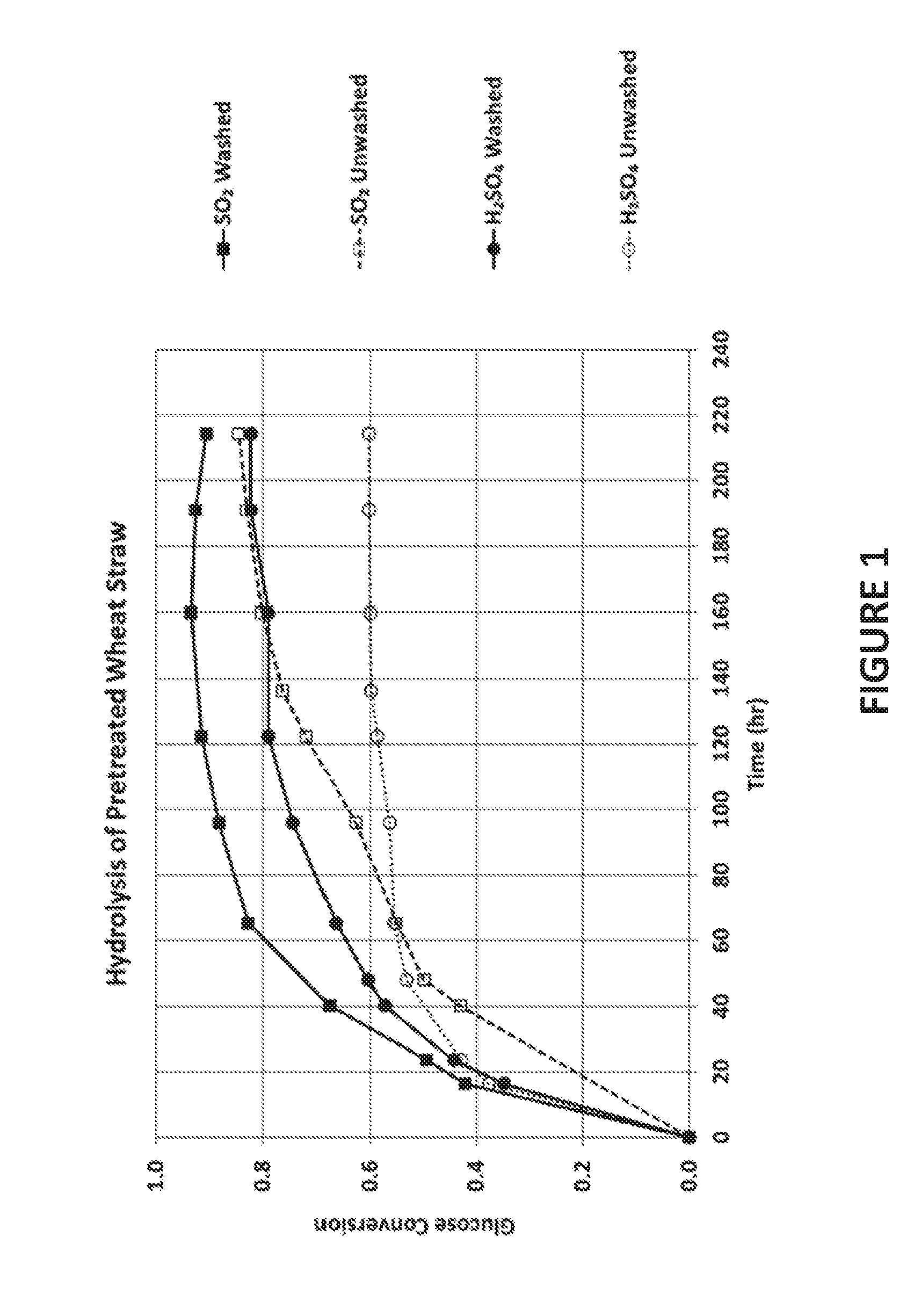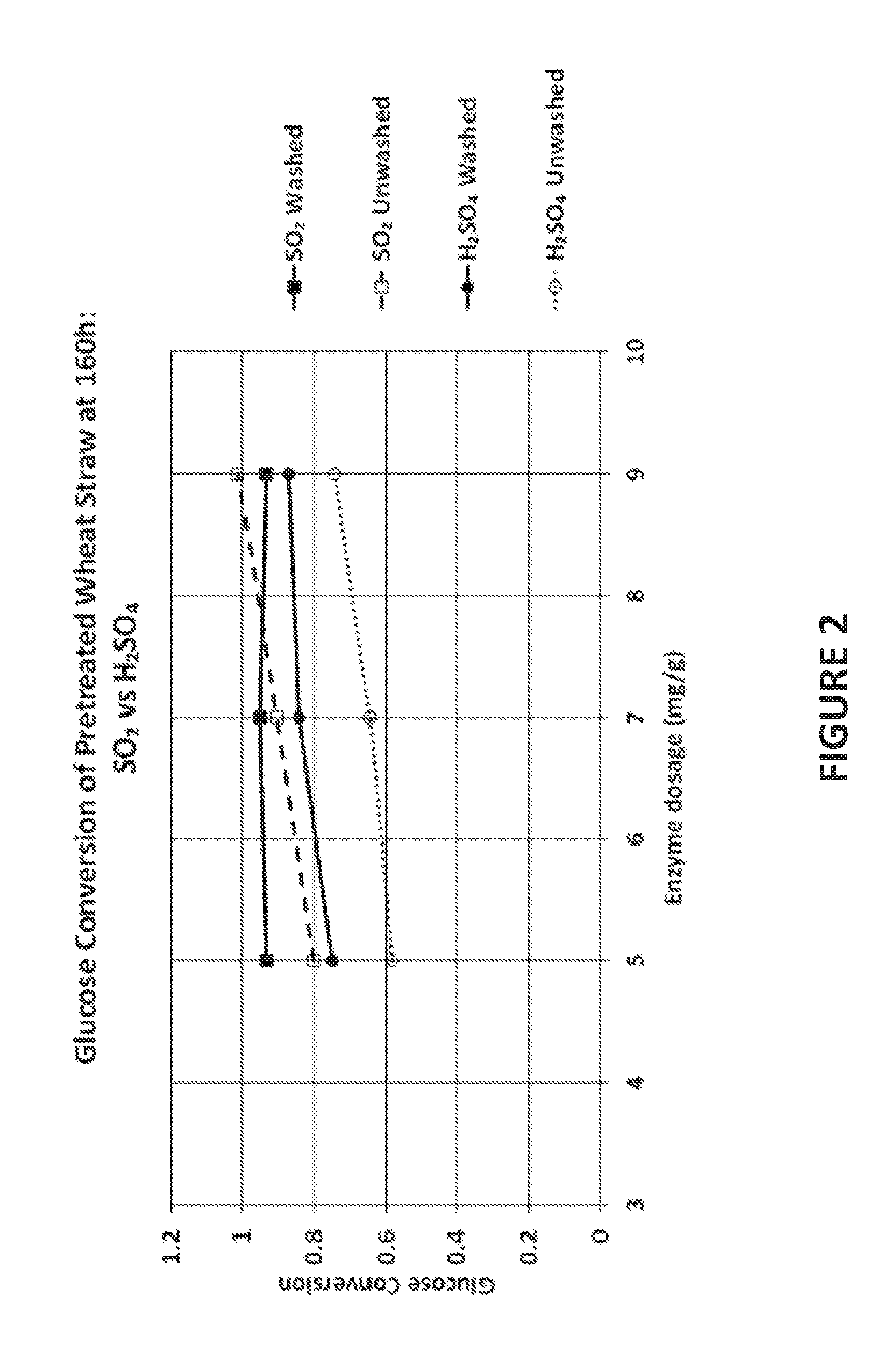Process comprising sulfur dioxide and/or sulfurous acid pretreatment and enzymatic hydrolysis
a technology of enzymatic hydrolysis and sulfur dioxide, which is applied in the field of process comprising sulfur dioxide and/or sulfurous acid pretreatment and enzymatic hydrolysis, can solve the problems of significant reduction of increased process cost, and difficult washing steps, etc., and achieves the effect of reducing or eliminating washing and/or water dilution, reducing or eliminating the performance of enzymatic hydrolysis
- Summary
- Abstract
- Description
- Claims
- Application Information
AI Technical Summary
Benefits of technology
Problems solved by technology
Method used
Image
Examples
example 1
SO2 Catalyzed Pretreatment of Lignocellulosic Material
[0099]An SO2 catalyzed batch pretreatment of wheat straw was conducted in 25 mL, stainless steel, laboratory tubular reactors (i.e., about 5 inches in length). The wheat straw was hammer-milled to provide an average particle size of ¼ inch-1 inch (0.635-2.54 cm) and had a cellulose / glucan content of 34.61%, xylan content of 20.09%, a lignin content of 20.49% and a total solids (TS) content of 93.25%, w / w on a dry basis. The carbohydrate assay was based on Determination of Structural Carbohydrates and Lignin in Biomass-LAP (Technical Report NREL / TP-510-42618).
[0100]Each tubular reactor was charged with approximately 1.646 g of accurately weighed wheat straw and 3.47 mL of sulfurous acid solution (≧6% H2SO3, from Sigma-Aldrich), thus providing a slurry having a consistency of about 30 wt % and a pH of 1.1. Each tubular reactor was repeatedly shaken / inverted such that the wheat straw was soaked in the sulfurous acid for at least 1 m...
example 2
H2SO4 Catalyzed Pretreatment of Lignocellulosic Material
[0106]A H2SO4 catalyzed batch pretreatment of wheat straw was conducted in a 97 L steam gun, for comparison with the SO2-catalyzed pretreatment. The wheat straw was hammer-milled to provide an average particle size of about ¼ inch-1 inch (0.635-2.54 cm) and had a cellulose / glucan content of 34.61%, a xylan content of 20.09%, a lignin content of 20.49%, and a total solids content of 89.5%, w / w on a dry basis.
[0107]To prepare for pretreatment, 400 g of the wheat straw was soaked overnight in a solution prepared from 22.3 mL of 96.5% H2SO4 and 6.72 L of water, thus providing a slurry having a consistency of about 5% and a pH of 1.30. Excess H2SO4 solution was drained from the wheat straw, which was then placed in a Bock basket centrifuge for 30 seconds. The centrifuged, H2SO4 soaked, lignocellulosic feedstock, which had a total solids (TS) concentration of 29.18%, was then stored at about 4° C.
[0108]The steam gun, which was prehea...
example 3
Determination of Undissolved Solids Concentration
[0113]The determination of the undissolved solids (UDS) content, also referred to as the consistency, is carried out as follows. A fixed amount of a sample containing undissolved solids is dispensed into a plastic weigh dish and the weight is recorded accurately using an analytical scale. A glass microfiber filter paper circle of pore size 1.6 microns, appropriately sized for a Buchner funnel, is placed in an aluminum weighing tin and the combined weight of the tin and filter paper is recorded. After transferring the pre-weighed filter paper to the Buchner funnel, the pre-weighed sample is passed through the filter paper to isolate the solids. Small volumes of de-Ionized water are used to ensure that the solids are quantitatively transferred from the weigh dish to the Buchner funnel. The solids are then washed using excess deionized water, after which the washed sample and filter paper are transferred into the pre-weighed aluminum tin...
PUM
| Property | Measurement | Unit |
|---|---|---|
| temperature | aaaaa | aaaaa |
| temperature | aaaaa | aaaaa |
| residence time | aaaaa | aaaaa |
Abstract
Description
Claims
Application Information
 Login to View More
Login to View More - R&D
- Intellectual Property
- Life Sciences
- Materials
- Tech Scout
- Unparalleled Data Quality
- Higher Quality Content
- 60% Fewer Hallucinations
Browse by: Latest US Patents, China's latest patents, Technical Efficacy Thesaurus, Application Domain, Technology Topic, Popular Technical Reports.
© 2025 PatSnap. All rights reserved.Legal|Privacy policy|Modern Slavery Act Transparency Statement|Sitemap|About US| Contact US: help@patsnap.com



